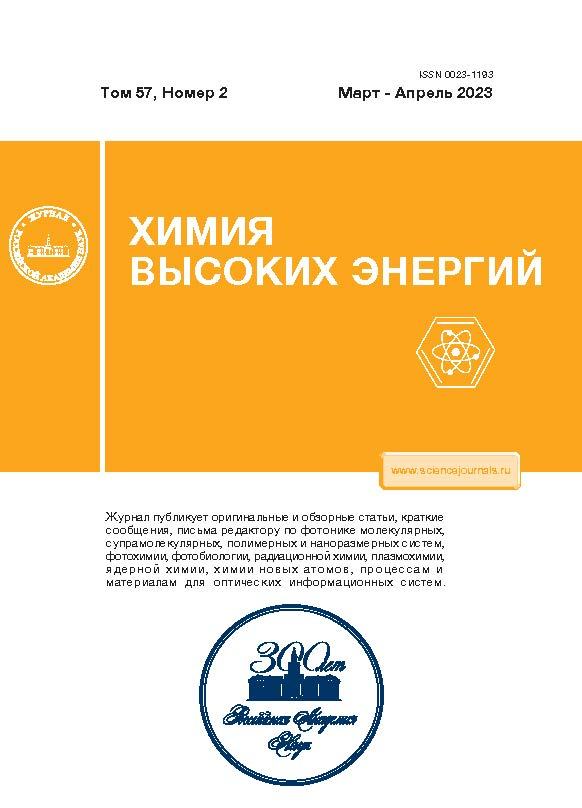Degradation of the Chromophore Functions of Dyes in Irradiated Solutions
- Authors: Kholodkova E.M.1, Ponomarev A.V.1
-
Affiliations:
- Frumkin Institute of Physical Chemistry and Electrochemistry, Russian Academy of Sciences
- Issue: Vol 57, No 2 (2023)
- Pages: 139-143
- Section: RADIATION CHEMISTRY
- URL: https://rjeid.com/0023-1193/article/view/661519
- DOI: https://doi.org/10.31857/S0023119323020079
- EDN: https://elibrary.ru/NGVDBL
- ID: 661519
Cite item
Abstract
Radiolysis damages the system of conjugated bonds and thus leads to the degradation of the chromophore functions of dyes in aqueous solutions. Ten representatives of quinophthalone, indigo, triphenylmethane, and azo dyes exhibited the same type of correlations between the absorbed dose and the degree of discoloration. It was shown using the method of competing scavengers that the color of aerated solutions decreased mainly due to the addition of OH radicals to the dyes. The radiation-chemical yields of discoloration ranged from 0.03 to 0.11 μmol/J and increased depending on the length of bond conjugation in the dye molecules. For practical electron-beam discoloration of dye solutions with a concentration of 20 mg/dm3, an
absorbed dose of 1–1.5 kGy was sufficient.
Keywords
About the authors
E. M. Kholodkova
Frumkin Institute of Physical Chemistry and Electrochemistry, Russian Academy of Sciences
Email: ponomarev@ipc.rssi.ru
Moscow, 119071 Russia
A. V. Ponomarev
Frumkin Institute of Physical Chemistry and Electrochemistry, Russian Academy of Sciences
Author for correspondence.
Email: ponomarev@ipc.rssi.ru
Moscow, 119071 Russia
References
- Traven V.F. // Frontier Orbitals and Properties of Organic Molecules (Ellis Horwood Series in Organic Chemistry), Mellor, J. ed. Ellis Horwood Ltd, NY. 1992.
- Arora S. // J. Bioremediation Biodegrad. 2014. V. 5. P. e146. https://doi.org/10.4172/2155-6199.1000e146
- Tkaczyk A., Mitrowska K., Posyniak A. // Sci. Total Environ. 2020. V. 717. P. 137222. https://doi.org/10.1016/j.scitotenv.2020.137222
- Rocha O.P., Cesila C.A., Christovam E.M., Barros S.B., Zanoni M.V., de Oliveira D.P. // Toxicology. 2017. V. 376. P. 113. https://doi.org/10.1016/j.tox.2016.04.002
- Collivignarelli M.C., Abbà A., Carnevale Miino M., Damiani S. // J. Environ. Manage. 2019. V. 236. P. 727. https://doi.org/10.1016/j.jenvman.2018.11.094
- Kholodkova E.M., Imatdinova D.N., Ponomarev A.V. // High Energy Chem. V. 54(4). P. 296. https://doi.org/10.1134/S0018143920030078
- Ponomarev A.V., Kholodkova E.M., Bludenko A.V. // Radiat. Phys. Chem. 2022. V. 199. P. 110357. https://doi.org/10.1016/j.radphyschem.2022.110357
- Ponomarev A.V., Ershov B.G. // Environ. Sci. Technol. 2020. V. 54. P. 5331. https://doi.org/10.1021/acs.est.0c00545
- Woods R., Pikaev A. // Applied Radiation Chemistry. Radiation Processing. Wiley. NY. 1994.
- Wojnárovits L., Takács E. // J. Radioanal. Nucl. Chem. 2017. V. 311. P. 973. https://doi.org/10.1007/s10967-016-4869-3
- Ponomarev A.V. // Radiat. Phys. Chem. 2020. V. 172. P. 108812. https://doi.org/10.1016/j.radphyschem.2020.108812
- Alkhuraiji T.S., Boukari S.O.B., Alfadhl F.S. // J. Hazard. Mater. 2017. V. 328. P. 29. https://doi.org/10.1016/j.jhazmat.2017.01.004
- Kovács K., He S., Míle V., Földes T., Pápai I., Takács E., Wojnárovits L. // Radiat. Phys. Chem. 2016. V. 124. P. 191. https://doi.org/10.1016/j.radphyschem.2015.10.028
- Paul J., Naik D.B., Bhardwaj Y.K., Varshney L. // Radiat. Phys. Chem. 2014. V. 100. P. 38. https://doi.org/10.1016/j.radphyschem.2014.03.016
- Shen Y., Chu L., Zhuan R., Xiang X., Sun H., Wang J. // J. Environ. Manage. 2019. V. 232. P. 171. https://doi.org/10.1016/j.jenvman.2018.11.050
- Wang J., Chu L. // Radiat. Phys. Chem. 2016. V. 125. P. 56. https://doi.org/10.1016/j.radphyschem.2016.03.012
- Meeroff D.E., Bloetscher F., Shaha B. // Radiat. Phys. Chem. 2019. V. 168. P. 108541. https://doi.org/10.1016/j.radphyschem.2019.108541
Supplementary files

















